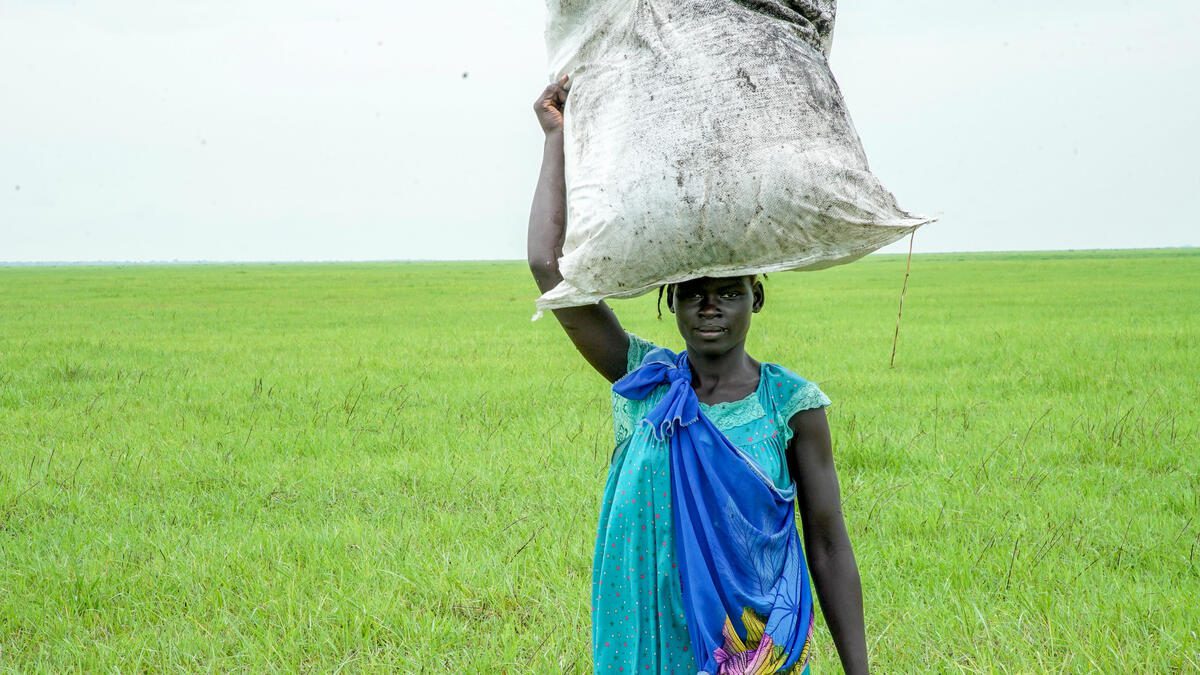Food & Cash Assistance
 WFP/Giulio d'Adamo
WFP/Giulio d'AdamoRestoring the dignity and dietary diversity back to families, by giving them the power to chose which foods to take home.
Hunger Has Many Causes
Hunger has many causes and conditions on the ground are constantly changing, which is why it’s vital for WFP to fight hunger with the right tool at the right time.
Sometimes, this means providing food directly, often in the form of raw grains, beans and cooking oil that people pick up at a distribution site. WFP might purchase the food in local markets or it can be provided by a donor government.
Collectively, this type of food assistance is called “in-kind” or “commodities.”
 WFP/Sabine Starke
WFP/Sabine Starke
In other situations, local markets are functioning and food is available – people simply can’t afford it. In these cases, WFP provides cash-based assistance in the form of food vouchers and e-cards, which enable families to purchase fresh and locally-grown food.
The power to choose groceries for themselves restores people’s dignity and dietary diversity. Cash-based assistance has the added benefit of strengthening local economies, supporting regional food producers, and significantly reducing food costs.
WFP can automatically upload funds onto e-cards, so communities in crisis can be reached faster and more efficiently.
The Food We Deliver
What are they?
Legumes such as lentils and chickpeas.
When and where are they used?
Often part of the staple food basket provided to a general population. Can also be provided to displaced populations who rely on food assistance to survive.
How are they used?
Transported in sacks and distributed as staple food items to be cooked. In developing countries, they’re often the most affordable and accessible source of protein.
Key Nutrients
High in vitamins and minerals like fiber, iron, B vitamins and folate; contains about two times the protein found in whole grain cereals like wheat, oats and barley.

What are they?
Edible grasses or seeds such as wheat, barley, oats, rice or corn.
When and where are they used?
Often part of the staple food basket provided to a general population. Can also be provided to displaced populations who rely on food assistance to survive.
How are they used?
Transported in sacks and distributed as staple food items to be cooked.
Key Nutrients
Grains are high in vitamins and minerals like Vitamins A, B6, C and Iron.

What are they?
Bars of baked wheat flour, vegetable fat, soya protein concentrate and malt extract.
When and where are they used?
In emergencies when local food can’t be distributed or prepared. Not for children under 6 months or in the first weeks of treatment of severe malnutrition.
How are they used?
Eaten straight from the package or mixed with water to make a porridge. Drinking water must be provided as the bars are compact and dry.
Key Nutrients
Vitamins A, B1, B2, B6, B12, C, D3, Folic acid, Calcium, Magnesium, Iron, Zinc, Potassium and Sodium

What are they?
Wheat-based biscuits that are fortified, pre-packaged and shelf-stable.
When and where are they used?
In the first days of an emergency when cooking facilities are scarce. Because they’re pre-packaged and compact, high-energy biscuits are easy to distribute and provide a quick solution to improve the level of nutrition without water or cooking.
Key Nutrients
10 to 15 g protein and 450 kcal of energy. Vitamins A, B1, B2, B6, B12, C, D, E, Calcium, Magnesium, Iron, Iodine, Folic Acid, Pantothenic Acid and Niacin.

What are they?
Blends of partially pre-cooked and milled cereals, soya and beans fortified with micronutrients. Special formulas may contain vegetable oil or milk powder.
When and where are they used?
To provide protein supplements; as part of WFP’s school meals program; as part of programs to prevent and address nutritional deficiencies among mothers and children; and to provide extra micronutrients to complement the general ration.
How are they used?
Usually mixed with water and cooked as a porridge.
Key Nutrients
Vitamins A, B6, B12, C, Folic acid, Zinc, Iron, Calcium and Potassium.
 Canva/WFP
Canva/WFPWhat are they?
A tasteless powder containing the recommended daily intake of 16 vitamins and minerals.
When and where are they used?
Useful as an alternative to fortified blends or when those blends are inadequate for specific groups.
How are they used?
One sachet per person is sprinkled onto home-prepared food after cooking and just before eating. Can also be used in school meal programs.
Key Nutrients
Vitamins A, B12, C, D, E, K, Pyridoxine, Folic Acid, Niacin, Zinc, Iron, Selenium and Iodine.
 WFP/Saikat Mojumder
WFP/Saikat MojumderWhat are they?
Specially designed products for moderately malnourished children. May contain vegetable fat, dry skimmed milk, sugar and whey.
When and where are they used?
In emergencies or in the prevention or treatment of moderate malnutrition. Complements breast milk and other food for children aged 6 to 59 months.
How are they used?
Weekly rations or one-day sachets (Plumpy’Doz or Plumpy Sup, by Nutriset) can be eaten directly from their containers. Designed to be eaten as a supplement to the regular diet.
Key Nutrients
Vitamins A, B1, B2, B6, B12, C, Calcium, Magnesium, Zinc, Iron, Potassium and Folic acid.
 WFP/Amadou Baraze
WFP/Amadou BarazeWhen and where are they used?
Often part of the staple food basket provided to a general population. Can also be provided to displaced populations who rely on food assistance to survive.
How are they used?
They are fortified with vitamins and used for both cooking and taste.
Key Nutrients
Vitamins A and D (oil) and Iodine (salt).

E-Cards in Action in Lebanon
Featured Stories
- News Release
- July 21, 2025
- News Release
- July 14, 2025





